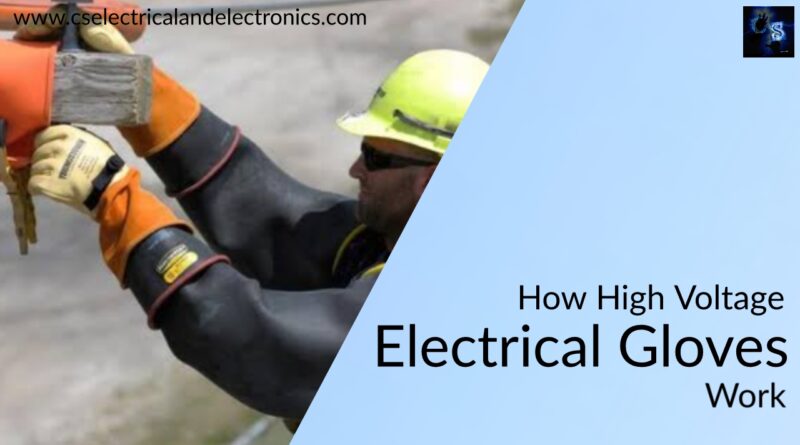How High Voltage Electrical Gloves Work And Are Made Up Of
Hello guys, welcome back to my blog. In this article, I will discuss how high voltage electrical gloves work and are made up of, what kind of gloves do electricians wear, factors determining the severity of the effect of electric shock, materials used in electrical gloves.
If you have any doubts related to electrical, electronics, and computer science, then ask question. You can also catch me @ Instagram – Chetan Shidling.
Also, read:
- Top 15 IoT Projects For Electrical Engineers, Electrical Engineering Project
- What Is Reactor, Types Of Reactors Used In Power Systems, Applications
- Top Types Of Testing On Power Transformers Done Before Use
How High Voltage Electrical Gloves Work
You can never take a chance when it comes to electricity since you never know when or how an electrical hazard will strike. As a result, whenever you handle or operate electricity, you must be well-equipped.
Rubber is one of these materials, and it’s the best at saving your money on power. And your hands are the most vulnerable area of your body when it comes to conducting electricity. Because rubber is a poor conductor of electricity, it resists the flow of electric current to your body, making it ideal for protecting against electrical risks.
There are numerous types of safety clothing available in the form of personal protective equipment (PPE) to protect you from the dangers of electricity. These garments are made of materials that are poor conductors of electricity and can prevent the flow of electricity from the circuit to your body.
High Voltage Electrical Gloves Works:
Rubber, as previously stated, is a poor conductor of electricity, which means it can be used to defend against electricity. Rubber is a natural insulator, preventing the current from passing through your skin.
Wearing gloves while working with electricity is required because, in the event of an electric shock from the source of electricity, rubber gloves will prevent electricity from making contact with your skin and the path of electricity to your body will be disconnected or restricted, protecting you from an electric shock while repairing an electric switch or appliance.
Free electrons are required for materials to conduct electricity, however, rubber lacks these free electrons and is hence considered safe as an anti electricity substance.
However, one thing to keep in mind is that the rubber used in the glove should be 100% rubber and not blended with any other material, or the work of protection will be compromised.
Although rubber is a better insulator than leather, leather protectors are put within the rubber gloves to provide a thick layer. Leather protectors give a hefty layer to the gloves, shielding the hands from cuts and abrasions from wires and sharp objects, while rubber gloves work as an insulator from electric current.
It’s extremely improbable that you’ll get a shock while wearing your rubber gloves. However, even with rubber gloves on, there are some situations in which fair play is impossible. Let’s find out what they are!
- If your rubber gloves aren’t particularly thick, there’s a chance that some current (albeit a little quantity) will pass through your body.
- If the rubber gloves have holes or are damaged by cuts, current can pass through them and into the body.
- If your hands are damp or sweaty, they are more likely to attract currents.
- Non-specified rubber gloves (those that are not designated as safe for electrical use) may accumulate static charge, which can then be transferred to your body.
As a result, even if you’re using rubber gloves, be sure they’re stamped “safe for electrical use” because electricity can never be trusted to not produce a hazard in any manner.
What kind of gloves do electricians wear?
An electrician should select gloves with the following features:
- Material: First and foremost, the gloves should be constructed of rubber, with a leather protector included. The gloves are made of non-flammable material, which is the next point to mention.
- Rubber with a layer of leather protection on top of it provides the optimum insulation.
- Fit: The gloves should be snug against your palms. It should be as loose as possible.
Also, according to OSHA, there are six different types of electrician gloves:
- Class 00: for use with AC voltages up to 500V
- Class 0: for use with AC voltages up to 1000V
- Class 1: for use with AC voltages up to 7,500V
- Class 2: for use with AC voltages up to 17,000V
- Class 3: voltage range of up to 26,500V AC
- Class 4: for use with AC voltages up to 36,000V
Another classification is based on the gloves’ ozone resistance, with Type I offering no protection and Type II offering ozone resistance.
Factors determining the severity of the effect of electric shock:
The severity of damage is usually determined by the voltage of the electric current that the body is exposed to and the resistance of the body to impede the flow of electricity. Other considerations include:
- The route was taken by the current to enter your body.
- The time it takes for the electricity to move through the body.
- Your body’s ability to give resistance to the current flow.
- The voltage level originating from the contact source.
To summarise, your gloves are often the only thing between you and a high voltage jolt. When working on charged electrical equipment, choosing the correct electrical-insulating gloves can protect you from electrical current.
This was about ” How High Voltage Electrical Gloves Work “. I hope this article may help you all a lot. Thank you for reading.
Also, read:
- 10 Tips To Maintain Battery For Long Life, Battery Maintainance
- 10 Tips To Save Electricity Bills, Save Money By Saving Electricity
- 100 (AI) Artificial Intelligence Applications In The Automotive Industry
- 100 + Electrical Engineering Projects For Students, Engineers
- 1000+ Control System Quiz, Top MCQ On Control System
- 1000+ Electrical Machines Quiz, Top MCQs On Electrical Machines
- 1000+ MATLAB Simulink Projects For MTech, Engineering Students
- 50 Tips To Save Electricity At Home, Shop, Industry, Office
Author Profile
- Chetu
- Interest's ~ Engineering | Entrepreneurship | Politics | History | Travelling | Content Writing | Technology | Cooking
Latest entries
 All PostsApril 19, 2024What Is Vector CANoe Tool, Why It Is Used In The Automotive Industry
All PostsApril 19, 2024What Is Vector CANoe Tool, Why It Is Used In The Automotive Industry All PostsApril 13, 2024What Is TCM, Transmission Control Module, Working, Purpose,
All PostsApril 13, 2024What Is TCM, Transmission Control Module, Working, Purpose, All PostsApril 12, 2024Top 100 HiL hardware in loop Interview Questions With Answers For Engineers
All PostsApril 12, 2024Top 100 HiL hardware in loop Interview Questions With Answers For Engineers All PostsMarch 22, 2024Driver Monitoring Systems In Vehicles, Working, Driver Sleepy Alert
All PostsMarch 22, 2024Driver Monitoring Systems In Vehicles, Working, Driver Sleepy Alert








